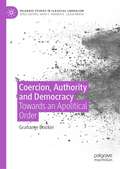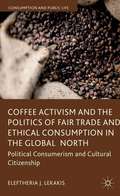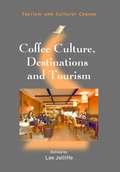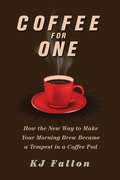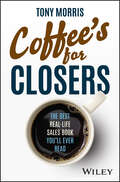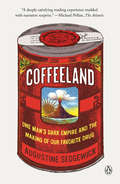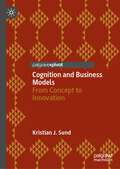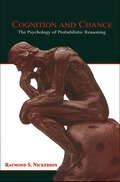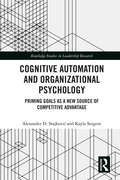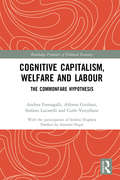- Table View
- List View
Coercion, Authority and Democracy: Towards an Apolitical Order (Palgrave Studies in Classical Liberalism)
by Grahame BookerClassical liberalism has typically sought to maintain as much room as possible for the exercise of personal initiative in the face of the encroachment of states. This book explores these questions of coercion and authority in the context of the size and scope of the state and argues that the state and its agents should be held to the same moral rules as are the individuals it rules over. The book considers how a distinct feature of the state is its police or coercive power, about which one may ask how the state acquires it and what if anything would justify its use. It considers the implication that there is nothing inherent about state agents that entitles one to behave in ways that we would not accept from a private actor, and how once that argument is made, the state’s claim to authority is weakened. The author also discusses the extent to which democracy has been thought to provide any sort of justification for coercion or authority. This book will be of interest to academics and students of political philosophy, especially classical liberalism, and legal philosophy.
Coercive Cooperation: Explaining Multilateral Economic Sanctions
by Lisa L. MartinThis innovative study shows that multilateral sanctions are coercive in their pressure on their target and in their origin: the sanctions themselves frequently result from coercive policies, with one state attempting to coerce others through persuasion, threats, and promises. To analyze this process, Lisa Martin uses a novel methodology combining game-theoretic models, statistical analysis, and case studies. She emphasizes that credible commitments gain international cooperation, and concludes that the involvement of international institutions and the willingness of the main "sender" to bear heavy costs are the central factors influencing the sanction's credibility.
Coffee Activism and the Politics of Fair Trade and Ethical Consumption in the Global North: Political Consumerism and Cultural Citizenship
by Eleftheria J. LekakisThis book explores the politics borne of consumption through the case of coffee activism and ethical consumption. It analyses the agencies, structures, repertoires and technologies of promotion and participation in the politics of fair trade consumption through an exploration of the relationship between activism and consumption.
Coffee Culture, Destinations and Tourism
by Lee JolliffeThis book explores the various aspects of coffee culture around the globe, relating the rich history of this beverage and the surroundings where it is produced and consumed to coffee destination development and to the visitor experience. Coffee and tourism venues explored range from the café districts of Australia, Canada, Germany and New Zealand to the traditional and touristic coffee houses of Malaysia and Cyprus to coffee-producing destinations in Africa, Asia, Latin America and the Pacific. This is a must-read for those interested in understanding coffee in relation to hospitality and tourism. Readers should gain a new appreciation of the potential for coffee-related tourism to contribute to both destination development and pro-poor tourism objectives.
Coffee Nation: How One Commodity Transformed the Early United States (Early American Studies)
by Michelle Craig McDonaldIlluminates how coffee tied the economic future of the early United States to the wider Atlantic worldCoffee is among the most common goods traded and consumed worldwide, and so omnipresent its popularity is often taken for granted. But even everyday habits have a history. When and why coffee become part of North American daily life is at the center of Coffee Nation. Using a wide range of archival, quantitative, and material evidence, Michelle Craig McDonald follows coffee from the slavery-based plantations of the Caribbean and South America, through the balance sheets of Atlantic world merchants, into the coffeehouses, stores, and homes of colonial North Americans, and ultimately to the growing import/export businesses of the early nineteenth-century United States that rebranded this exotic good as an American staple. The result is a sweeping history that explores how coffee shaped the lives of enslaved laborers and farmers, merchants and retailers, consumers and advertisers.Coffee Nation also challenges traditional interpretations of the American Revolution, as coffee’s spectacular profitability in US markets and popularity on the new nation’s tables by the mid-nineteenth century was the antithesis of independence. From its beginnings as a colonial commodity in the early eighteenth century, coffee’s popularity soared to become a leading global economy by the 1830s. The United States dominated this growth, by importing ever-increasing amounts of the commodity for drinkers at home and developing a lucrative re-export trade to buyers overseas. But while income generated from coffee sales made up an expanding portion of US trade revenue, the market always depended on reliable access to a commodity that the nation could not grow for itself. By any measure, the coffee industry was a financial success story, but one that runs counter to the dominant narrative of national autonomy. Distribution, not production, lay at the heart of North America’s coffee business, and its profitability and expansion relied on securing and maintaining ties first with the Caribbean and then Latin America.
Coffee Wars in India: Caf Coffee Day 2013
by David B. Yoffie Rachna TahilyaniCaf Coffee Day (CCD) is the largest coffee retailer in India. In 2012, Starbucks entered the India market. This case explores CCD's competitive advantages, its analysis of Starbuck's entry strategy, and how it might respond to Starbucks' entry.
Coffee Wars in India: Caf Coffee Day 2013
by David B. Yoffie Rachna TahilyaniCaf Coffee Day (CCD) is the largest coffee retailer in India. In 2012, Starbucks entered the India market. This case explores CCD's competitive advantages, its analysis of Starbuck's entry strategy, and how it might respond to Starbucks' entry.
Coffee Wars in India: Caf Coffee Day 2015
by David B. Yoffie Rachna TahilyaniThis case is an update of "Coffee Wars in India: Caf Coffee Day 2013." It explores Caf Coffee Day's progress after Starbuck's entry into India and the decisions it faces in 2015.
Coffee Wars in India: Cafe Coffee Day Takes on the Global Brands
by David B. Yoffie Tanya BijlaniCaf Coffee Day (CCD) is contemplating how to respond to the entry of Starbucks into the Indian coffee chain market. The case study describes the emergence of CCD as the leading coffee chain in India, with over 1,400 cafes in India. In early 2013, Starbucks, the world's leading coffee chain company, opened its first 11 outlets in India's metropolitan cities with local giant, Tata, and promises of a national roll out. CCD management debated whether there was plenty of room for both Starbucks and CCD in India's large growing market, or whether Starbucks' entry required CCD to respond more assertively.
Coffee Wars in India: Cafe Coffee Day Takes on the Global Brands
by David B. Yoffie Tanya BijlaniCaf Coffee Day (CCD) is contemplating how to respond to the entry of Starbucks into the Indian coffee chain market. The case study describes the emergence of CCD as the leading coffee chain in India, with over 1,400 cafes in India. In early 2013, Starbucks, the world's leading coffee chain company, opened its first 11 outlets in India's metropolitan cities with local giant, Tata, and promises of a national roll out. CCD management debated whether there was plenty of room for both Starbucks and CCD in India's large growing market, or whether Starbucks' entry required CCD to respond more assertively.
Coffee Wars in India: Starbucks 2012
by David B. Yoffie Rachna TahilyaniStarbucks entered India in late 2012. This case explores Starbucks' globalization strategy, its success in China, and its vision for India. The case asks whether Starbuck can replicate its success in China in India.
Coffee Wars in India: Starbucks 2015
by David B. Yoffie Rachna TahilyaniThis case examines the progress made by Starbucks in its first two years of operation in India.
Coffee and Community
by Sarah LyonWe are told that simply by sipping our morning cup of organic, fair-trade coffee we are encouraging environmentally friendly agricultural methods, community development, fair prices, and shortened commodity chains. But what is the reality for producers, intermediaries, and consumers? This ethnographic analysis of fair-trade coffee analyzes the collective action and combined efforts of fair-trade network participants to construct a new economic reality. Focusing on La Voz Que Clama en el Desierto-a cooperative in San Juan la Laguna, Guatemala-and its relationships with coffee roasters, importers, and certifiers in the United States, Coffee and Community argues that while fair trade does benefit small coffee-farming communities, it is more flawed than advocates and scholars have acknowledged. However, through detailed ethnographic fieldwork with the farmers and by following the product, fair trade can be understood and modified to be more equitable. This book will be of interest to students and academics in anthropology, ethnology, Latin American studies, and labor studies, as well as economists, social scientists, policy makers, fair-trade advocates, and anyone interested in globalization and the realities of fair trade.
Coffee for One: How the New Way to Make Your Morning Brew Became a Tempest in a Coffee Pod
by Kj FallonReminiscent of God in a Cup and The Devil’s Cup, this is an inside look into the modern business of making coffee. But rather than a general history, Coffee for One focuses on the revolution that made single serve such a popular way to consume coffee worldwide, and the competition and conflict that got us here. This story features A-list names, corporate intrigue, environmental controversy, and much, much more. For the vast majority of the time humans have consumed coffee, the drink has been brewed in pots or other multi-serving tools; that is, until the last two decades, which saw the rise of the single serve coffee machine. Whether it’s a Keurig or a Nespresso, today a lot of people get their coffee from little plastic individual serving pods. But why? Coffee for One breaks open this story of innovation, profit, and cultural change.
Coffee's for Closers: The Best Real Life Sales Book You'll Ever Read
by Tony MorrisPractical, real-world sales advice you can apply immediately to improve your numbers In Coffee’s For Closers: The Best Real Life Sales Book You’ll Ever Read, veteran sales leader and coach Tony Morris delivers a can’t-miss, hands-on guide to becoming the best salesperson you can be. This is not a book filled with high-level theories – rather it is a book that offers innovative and easy-to-understand sales techniques you can apply immediately and integrate into your daily life as a salesperson. In the book, you’ll explore tried-and-true, step-by-step tutorials on getting past gatekeepers, cold-calling, questioning, listening to customers, and crafting airtight proposals. You’ll also find: Expert tips on gaining commitment and closing, as well as advice on how to handle prospects’ objections and stalling tactics Ways to generate leads, build rapport with customers, prepare for your next sales call, and even manage your time wisely Strategies for handling rejection - a frequently encountered experience for every salespersonA practical blueprint for sales success that is heavily informed by real-world experience and commonsense, Coffee’s For Closers will become one of those essential resources you rely on to inform your everyday approach to sales.
Coffee: The Epic of a Commodity
by H. E. Jacob"A cup of coffee is a miracle, a wonderful assemblage of relationships”. This classic follows coffee's journey around the world, from London to Brazil, telling in fascinating detail and amusing anecdote the singular history of the legendary commodity, from its discovery that chewing on the beans were keeping goats awake in Yemen to the author’s own experiences with the bean in 1935. Referred to as a "documentary novel” back during its inception, H. E. Jacobs pioneered the concept of creative nonfiction, combining the reality of nonfiction with the epic presentation and prose of fiction. This genre exploded into popularity and remains so today. Coffee tells the story of this popular beverage in short, fun to read essays that will entertain anyone that enjoys a good, strong cup of coffee.
Coffeeland: One Man's Dark Empire and the Making of Our Favorite Drug
by Augustine SedgewickThe epic story of how coffee connected and divided the modern worldCoffee is an indispensable part of daily life for billions of people around the world--one of the most valuable commodities in the history of global capitalism, the leading source of the world's most popular drug, and perhaps the most widespread word on the planet. Augustine Sedgewick's Coffeeland tells the hidden and surprising story of how this came to be, tracing coffee's five-hundred-year transformation from a mysterious Muslim ritual into an everyday necessity.This story is one that few coffee drinkers know. It centers on the volcanic highlands of El Salvador, where James Hill, born in the slums of Manchester, England, founded one of the world's great coffee dynasties at the turn of the twentieth century. Adapting the innovations of the Industrial Revolution to plantation agriculture, Hill helped to turn El Salvador into perhaps the most intensive monoculture in modern history, a place of extraordinary productivity, inequality, and violence. Following coffee from Hill family plantations into supermarkets, kitchens, and workplaces across the United States, and finally into today's ubiquitous cafés, Sedgewick reveals how coffee bred vast wealth and hard poverty, at once connecting and dividing the modern world. In the process, both El Salvador and the United States earned the nickname "Coffeeland," but for starkly different reasons, and with consequences that reach into the present. This extraordinary history of coffee opens up a new perspective on how the globalized world works, ultimately provoking a reconsideration of what it means to be connected to faraway people and places through the familiar things that make up our day-to-day lives.
Cofidis
by Luc WathieuAn offspring of French catalog marketer 3 Suisses, and a popular sponsor of Tour de France, Cofidis sells consumer credit over the phone, defying conventional banking with a product policy and a communication strategy that perfectly fits the company's comparative (dis)advantages. This case describes: Cofidis' product and value proposition; the evolving competitive context and cultural complexity of the European credit market; the adaptive marketing strategy of the company, which evolved from bundling with the 3 Suisse catalog, to direct mail, to print advertising in TV guides, to bicycling sponsorship, the results of the strategy; and the challenge and opportunities posed by the Internet. Based on the lessons of the past, can we advise Michel Guillois, CEO of Cofidis, on the best way for him to preserve Cofidis' competitive edge?
Cognition and Business Models: From Concept to Innovation
by Kristian J. SundThis book explores how theories of cognition inform our theoretical understanding of business models and business model innovation. A business model can either be viewed as an objective description of an activity system, or as an abstract, conceptual, and perceptual construct, that is the result of cognition. From this second point of view, the business model becomes a schematic mental model that is created, shaped, and shared over time. In other words, managers hold in their mind perceptual constructs that constitute schemas of the business model.This book examines how the underlying processes of the creation, shaping, and sharing of business (mental) models take place at individual, organizational, and even inter-organizational levels. Theories of managerial and organizational cognition are explored to inform our understanding of business modelling and business model innovation. The reader is thus provided with an overview of existing literature and reflections on future avenues of research to explore the cognitive foundations of business modelling.
Cognition and Chance: The Psychology of Probabilistic Reasoning
by Raymond S. NickersonLack of ability to think probabilistically makes one prone to a variety of irrational fears and vulnerable to scams designed to exploit probabilistic naiveté, impairs decision making under uncertainty, facilitates the misinterpretation of statistical information, and precludes critical evaluation of likelihood claims. Cognition and Chance presents an overview of the information needed to avoid such pitfalls and to assess and respond to probabilistic situations in a rational way. Dr. Nickerson investigates such questions as how good individuals are at thinking probabilistically and how consistent their reasoning under uncertainty is with principles of mathematical statistics and probability theory. He reviews evidence that has been produced in researchers' attempts to investigate these and similar types of questions. Seven conceptual chapters address such topics as probability, chance, randomness, coincidences, inverse probability, paradoxes, dilemmas, and statistics. The remaining five chapters focus on empirical studies of individuals' abilities and limitations as probabilistic thinkers. Topics include estimation and prediction, perception of covariation, choice under uncertainty, and people as intuitive probabilists. Cognition and Chance is intended to appeal to researchers and students in the areas of probability, statistics, psychology, business, economics, decision theory, and social dilemmas.
Cognition and Extended Rational Choice
by Howard MargolisOne of the most exciting recent innovations in the social sciences has been the emergence of 'behaviour economics', which extends the notion of rational choice to allow for both motivation beyond self-interest and intuitions that cannot be reduced to the logic of a situation. This new book by Howard Margolis demonstrates how an account of widely-di
Cognitive Automation and Organizational Psychology: Priming Goals as a New Source of Competitive Advantage (Routledge Studies in Leadership Research)
by Alexander D. Stajkovic Kayla SergentJobs that were once well-defined are now multifaceted. New realities have placed a premium on employee cognitive processing to fulfill complex occupational roles. But human conscious cognitive capacity is limited, making it nearly impossible for employees to keep up without being overloaded. Stajković and Sergent refute the common assumption that technological automation is the only way forward. Instead, they directly tackle the issue of employee cognitive overload by proposing cognitive automation as an alternative solution. The authors present a sampling of cutting-edge research showing that conscious guidance is not required for all goal pursuits; goal-directed behavior at work can be automated via priming of subconscious goals. Building on research in social psychology and organizational behavior, Stajković and Sergent introduce four models to explain how subconscious goals are primed in organizations: •Auto-motive model: Repeated practice with a goal makes cognitive automation possible. •Goal contagion: Observing and inferring goals of others creates cognitive automation. •Means-goal priming: Confidence in your goal pursuit enhances cognitive automation. •A history of reinforcement: Money, feedback, and social recognition used to reinforce goal achievement become associated with the goal, resulting in cognitive automation. The authors canvas a broad range of knowledge concerning the problem of employee cognitive overload in contemporary organizations and rely on multidisciplinary research to propose cognitive automation as a solution that can address it directly. This book is a deep well of valuable information for those interested in solving real work problems with application of science of organizational behavior (SOB).
Cognitive Capitalism, Welfare and Labour: The Commonfare Hypothesis (Routledge Frontiers of Political Economy)
by Andrea Fumagalli Alfonso Giuliani Stefano Lucarelli Carlo VercelloneThis book deals with the transformations of both accumulation process and labour in the transition from a Fordist to a cognitive capitalism paradigm, with specific regard to Western economies. It outlines the advent, after industrial capitalism, of a new phase of the capitalist system in which the value of cognitive labour becomes dominant. In this framework, the central stakes of capital valorisation and forms of property are directly based on the control and privatization of the production of collective knowledge. Here, the transformation of knowledge itself, into a commodity or a fictitious capital, is analyzed. Building on this foundation, the authors outline their concept of ‘commonfare’. This idea of commonfare implies, as a prerequisite, the social re-appropriation of the gains arising from the exploitation of those social relations which are the basis of accumulation today. This re-appropriation does not necessarily lead to the transition from private to public ownership but it does make it necessary to distinguish between common goods and the commonwealth. This book explains this distinction and how common goods and the commonwealth require a different framework of analysis. This volume will be of great interest to all scholars and researchers, as well as a more general readership, who wish to develop a critical thinking of the mainstream analysis of this topic. Contributing to the "Marxism-heterodox" approach using rigorous theoretical analysis and empirical evidence, it is aimed at all those who act socially and aspire to a better understanding of the development and the contradictions of contemporary capitalism.
Cognitive Capitalism: Human Capital and the Wellbeing of Nations
by Heiner RindermannNations can vary greatly in their wealth, democratic rights and the wellbeing of their citizens. These gaps are often obvious, and by studying the flow of immigration one can easily predict people's wants and needs. But why are there also large differences in the level of education indicating disparities in cognitive ability? How are they related to a country's economic, political and cultural development? Researchers in the paradigms of economics, psychology, sociology, evolution and cultural studies have tried to find answers for these hotly debated issues. In this book, Heiner Rindermann establishes a new model: the emergence of a burgher-civic world, supported by long-term background factors, furthered education and thinking. The burgher-civic world initiated a reciprocal development changing society and culture, resulting in past and present cognitive capital and wealth differences. This is an important text for graduate students and researchers in a wide range of fields, including economics, psychology, sociology and political science, and those working on economic growth, human capital formation and cognitive development.
Cognitive Changes after Surgery in Clinical Practice (In Clinical Practice)
by Andrew SevernThis book reviews current knowledge about cognitive dysfunction in surgical patients to provide a common knowledge base and terminology. It covers the topic in a way that considers all points of view, and enables the reader to be better equipped to manage cognitive dysfunction in all its manifestations in surgical patients. This book will hopefully also be a source of generating future ideas for research.Cognitive Changes after Surgery in Clinical Practice has an internationally renowned group of authors, and is aimed firstly at the perioperative team: surgeon, anaesthetist and surgical ward nurses; secondly, the researcher or geriatrician; and thirdly, public health specialists and hospital managers.
